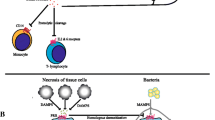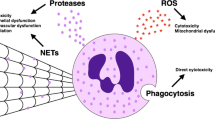Abstract
In a study of the clinical importance of polymorphonuclear granulocytes (PMN) for the monitoring of wound healing we investigated the postsurgical course of nine patients all of whom had undergone trauma surgery and had no wound complications. The “stimulated random PMN locomotion” was evaluated by a new migration filter device which preserves the cells in their genuine priming state, simulating in vivo conditions. The percentage of all activated PMN, expressed by the total migration index (TMI) reflected the highest median immediately after surgery (z max = 30.1 %) and dropped to the lowest value on day 13 (z max = 13.9%). The mean invasion depth (T/2) of the cells along the migration distance into the filter showed only slight variations over time. The neutrophil migration activity (NMA), described by T/2 and TMI, behaved in a similar way to TMI. In studying physiological healing, preliminary results indate that TMI, which expresses PMN activation, is an efficient tool in the postoperative monitoring of patients, and might in the future serve as a basis for an early warning system for wound healing complications.
Similar content being viewed by others
References
Boyden SV (1962) The chemotactic effect of mixtures of antibody and antigen on polymorphonuclear leucocytes. J Exp Med 15:453–466
Egger G (1984) The Sephadex model of inflammation. In: Fueger GF (ed) Blood cells in nuclear medicine, part II: Migratory blood cells. Boston The Hague Dortrecht Lancaster. Nijhoff, Boston, pp 103–116
Egger G (1990) Ein Membranfiltersystem zur Messung der Zellmigration. Patentapplication, Austria (AT 394 455 B)
Egger G, Allmayer T, Iberer F, Sabin K, Tscheliessnig KH, Auer T, Wasler A, Petutschnigg B (1993) A new PMN migration assay for monitoring immune suppression therapy after orthotopic heart transplantation. In: 5th Interscience World Conference on Inflammation, Antirheumatics, Analgesics, Immunomodulators. Geneva, 25–28 April 1993 (abstract 65)
Egger G, Klemt C, Kaulfersch W, Spendel S (1991) A new PMN migration test for a therapy control of juvenile rheumatoid arthritis (JRA). International Congress on Inflammation; Biennial Forum of Basic and Clinical Research. Rome, 6–11 Oct 1991
Follin P (1991) Mechanisms in neutrophil priming: characterisation of the oxidative response induced by formylmethionylleucyl-phenylalanine in human exsudated cells. Scand J Immunol 34:317–322
Hamilton T (1987) Molecular mechanisms of signal transduction in macrophages. Immunology Today 8:151–158
Henson PM, Henson JE, Fittschen C, Kimani G, Bratton DL, Riches DWH (1988) Phagocytic cells: degranulation and secretion. In: Gallin JI, Goldstein IM, Snyderman R (eds) Inflammation — basic principles and clinial correlates. Raven, New York, pp 363–390
Hofer HP, Kukovetz E, Petek W, Khoschsorur A, Wildburger R, Schweighofer F, Quehenberger F, Schaur RJ (1993) Biochemisches Wundmonitoring: Die PMN-Elastase bei unterschiedlichen Heilungsverläufen nach unfallchirurgisch-orthopädischen Eingriffen. Unfallchirurg 96:292–298
Jochum M, Fritz H, Nast-Kolb D, Inthorn D (1990) Granulozyten-Elastase als prognostischer Parameter. Dtsch Ärztebl 87:19
Lewis GP (1986) Mediators of inflammation. Wright, Bristol
Metchnikoff E (1887) Sur la lutte des cellules de l'organisme contre l'invasion des microbes. Ann Inst Pasteur 1:321–336
Schlag G, Redl H (1990) Endothelium as the interface beween blood and organ in the evolution of organ failure. In: Schlag G, Redl H, Siegel JH (eds) Shock, sepsis and organ failure. Springer, Berlin Heidelberg New York, pp 210–272
Tellado JM, Christou NV (1993) Activation state of polymorphonuclear leucocytes in surgical patients: characterization of surface receptor expression. Surgery 113:624–629
Windsor ACJ, Mullen PG, Fowler AA, Sugerman HJ (1993) Role of the neutrophil in adult respiratory distress syndrome. Br J Surg 80:10–17
Zigmond SH (1978) A model for understanding millipore filter assay systems. In: Gallin JI, Quie PG (eds) Leucocyte chemotaxis. Raven, New York, pp 87–93
Author information
Authors and Affiliations
Additional information
Work kindly supported by the AO/AS1F
Rights and permissions
About this article
Cite this article
Hofer, H.P., Kukovetz, E., Egger, G. et al. Polymorphonuclear leucocyte migration response in uneventful wound healing following trauma surgery. Arch Orthop Trauma Surg 113, 170–173 (1994). https://doi.org/10.1007/BF00441628
Issue Date:
DOI: https://doi.org/10.1007/BF00441628




